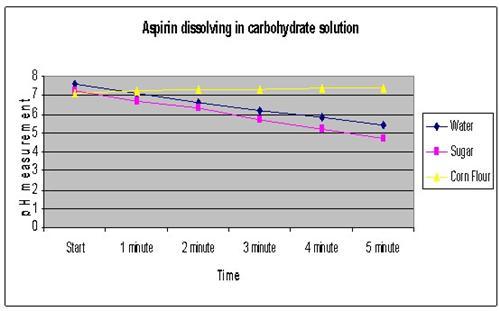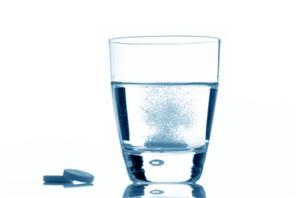| Complexity level: | 5 |
| Project cost ($): | 20 |
| Time required: | 1 hour for preparation, 1 hour for observation |
| Material availability: | Easily found. Aspirin may be purchased at a Chemist |
| Safety concerns: | None |
Hypothesis
The presence of carbohydrates will not affect the rate of dissolution of aspirin.
Overview
Aspirin
Aspirin is an analgesic medication used to relieve minor pains and reduce fever, and is also an anti-inflammatory medication. It is one of the most common and cheapest pain killers that can be bought easily over the counter in most drugstores.
The aspirin tablets are produced by mixing corn starch, distilled water and acetylsalicylic acid, which is also the active ingredient in the tablet. Other ingredients like the binding agents and fillers are also added and mixed together. The mixture is then compressed into tablets. Aspirin tablets are available in various sizes, weights, hardness and shapes depending on the dosages.
Aspirin is also used to help prevent blood clots, strokes and heart attacks. This is because of the ability of aspirin to inhibit thromboxane production. Aspirin is also given to patients immediately after a heart attack, in order to avoid a second attack and also to prevent cardiac tissue from dying. Some of the known side effects of aspirin are stomach ulcers, tinnitus, stomach bleeding and Reye’s syndrome.
Scientific Terms
Materials
The materials required for the science fair project:
- 3 transparent cups
- 3 aspirin tablets
- pH paper
- 1 stopwatch
- 1 bottle of water
- 1 teaspoon
- 1 packet of sugar
- 1 packet of corn flour
Procedure
1. For this science fair project, the independent variable is the solution in the cups - water, sugar water and water mixed with corn flour. The dependent variable is the pH of the solution in the cups. This is determined by checking the pH of the solution in the cups every minute for 5 minutes. The constants (control variables) are the size of the cups, the amount of water in the cups, the amount of carbohydrates added, the duration of the testing and the temperature of the environment, which will remain at room temperature.
2. Fill the 3 cups with bottled water. The 1st cup will be the control and will contain only water. Add one teaspoon of sugar to the 2nd cup and let it dissolve in the water. Add one teaspoon of corn flour to the 3rd cup and mix it into the water. Measure and record the initial pH of the solutions in the 3 cups in a table, as shown below.
3. Drop one tablet of aspirin in the 1st cup. As the aspirin dissolves in the water, the acetylsalicylic acid will make the mixture in the cup acidic and lower the pH of the solution. Check the pH of the solution in the cup every minute for the next 5 minutes. Record all the readings in a table, as shown below.
4. Repeat step 3 on the cups with sugar and corn flour added. Record the pH measurements in a table, as shown below.

Results
It is observed that the aspirin dissolved faster in the cup with water and the cup with sugar added to the water. The pH reading decreased at almost the same rate. However, the aspirin was slower to dissolve in the cup with the corn flour.
| Substance added | Effect of carbohydrates on aspirin absorption (pH values) | |||||
| Start | 1 minute | 2 minute | 3 minute | 4 minute | 5 minute | |
| Water | 7.6 | 7.1 | 6.6 | 6.2 | 5.8 | 5.4 |
| Sugar | 7.2 | 6.7 | 6.3 | 5.7 | 5.2 | 4.7 |
| Corn flour | 7.1 | 7.2 | 7.3 | 7.3 | 7.4 | 7.4 |
The results were then plotted onto a graph, as shown below

Conclusion
The hypothesis that the presence of carbohydrate will not affect the rate of dissolution of aspirin has been proven to be partially true. The aspirin dissolved at almost the same rate in the cups with water and the dissolved sugar. However, it was slower to dissolve in the cup with corn flour. This could perhaps be due to the higher viscosity of the corn flour solution. Further investigation is necessary to ascertain if this is indeed the cause.
Aspirin is one of the most common pain killers available to the public, and can be found in most drugstores. It is both cheap and safe to use, provided of course, that it is properly administered in correct quantities. An interesting fact - it is estimated that Americans consume about 16,000 tons of aspirin tablets a year. Aspirin is used to reduce the risk of heart attacks and strokes. It is also used to relieve headaches, pain and fever.
Also consider
This science fair project can also be repeated by using paracetamol or other similar medicines, instead of aspirin.
The experiment may also be modified to test the effects of temperature on the rate of dissolution of aspirin, by increasing the temperature of the solution from 25°C to 40°C.
References
Aspirin - http://en.wikipedia.org/wiki/Aspirin
Aspirin - http://www.madehow.com/Volume-1/Aspirin.html

